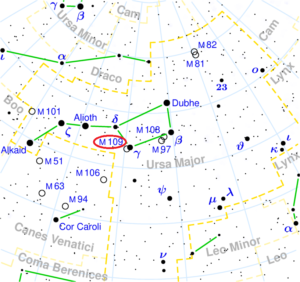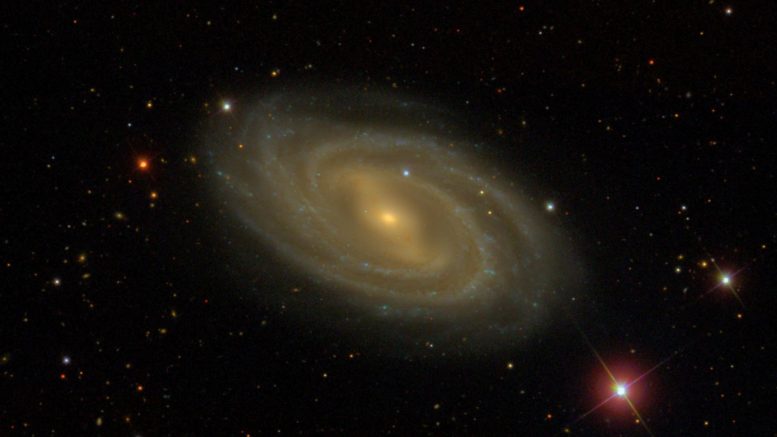Messier 109 is a barred spiral galaxy exhibiting a weak inner ring structure around the central bar. This is a great springtime galaxy to view regardless of where one lives and can easily be found near the Big Dipper asterism.
| Description | |
| Visible From Pacific Northwest | December to May |
| Best Time To Observe | January, February, and March |
| Minimum Size Of Viewing Device | Small Telescope |
| Object Type | Barred Spiral Galaxy |
| Designations | Messier 109, M109, NGC 3992, PGC 37617, UGC 6937, EQ 1155+536, TC 755, TC E19, Z 269-23, Z 1155.0+5339, UZC J115736.0+532229, IRAS 11549+5339, IRAS 11550+5339, 2MASX J11573598+5322282, MCG+09-20-044, SDSS J115735.97+532228.9 |
| Right Ascension | 11h 57m 36.0s |
| Declination | +53°22’28” |
| Constellation | Ursa Major |
| Number Of Stars | 1 Trillion |
| Apparent magnitude | +10.6 |
| Apparent dimensions | 7′.6 x 4′.7 |
| Object Radius | 90,000 light years |
| Distance From Earth | 83,500,000 light years |
History
Messier 109 was probably discovered by Charles Messier in the spring of 1781 while checking the position of two objects discovered by Pierre Méchain, who had found three objects in this region of the sky. Messier only determined the position for M97, the Owl Nebula, and mentioned the other two in his description. He added M109 to his personal copy of the catalogue in 1783, describing it as a “nebula near Gamma UMa, same right ascension a bit near this star and 1 deg… more south. Discovered by M. Méchain on March 12, 1781.”
Pierre Méchain mentioned M109 in a letter to Johann Bernoulli dated May 6, 1783:
A nebula near Beta in the Great Bear. Mr. Messier mentions, when indicating its position, two others, which I also have discovered and of which one is close to this one [Messier 108], the other is situated close to Gamma in the Great Bear [Messier 109], but I could not yet determine their positions.
William Herschel discovered M109 independently on April 12, 1789 and added it to his catalogue as H IV.61. Herschel misidentified the object as a planetary nebula
Locating M109 In The Sky
Its position is less than a degree southeast of Gamma Ursae Majoris – Phecda – the inside bottom corner star of the Big Dipper asterism

Viewing M109
The galaxy can be seen in large binoculars in exceptionally good conditions. 4-inch telescopes show a hazy streak of light, while 6-inch instruments reveal the galaxy’s nucleus surrounded by nebulosity. Only the galaxy’s bright central region with the bar can be seen visually.
Photographing M109
Photographing Messier 109 can be done by DSLR and by CMOS cameras, and there happen to be quite a few great guides to help. As a general rule and advice, being that the best detail is extracted with long exposures and luminance layering. Nice results can be obtained from suburban areas with as few as 2 hours of exposures. Utilize a long focal length to obtain high resolution and a frame of around 20 arcminutes or less.
Sources And Further Reading
Descriptions of all of Messier Objects can be found here.
https://freestarcharts.com/messier-109

Be the first to comment on "Messier 109"